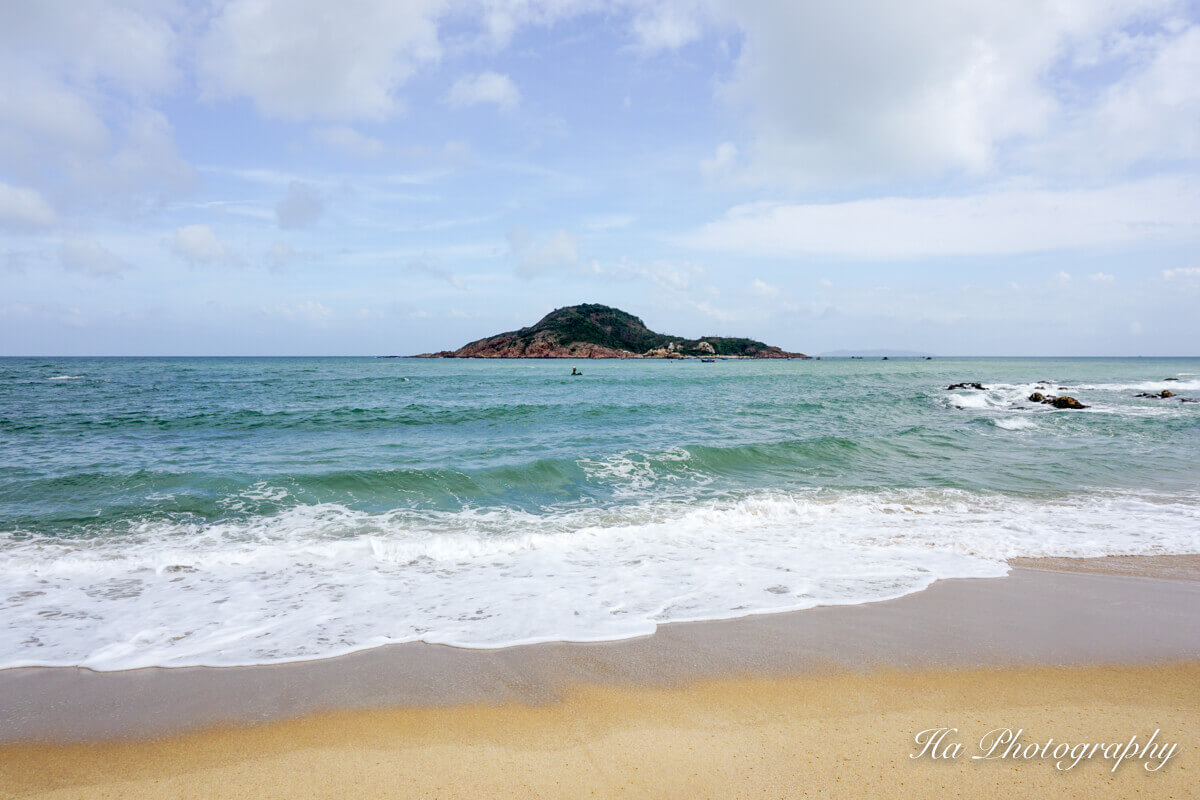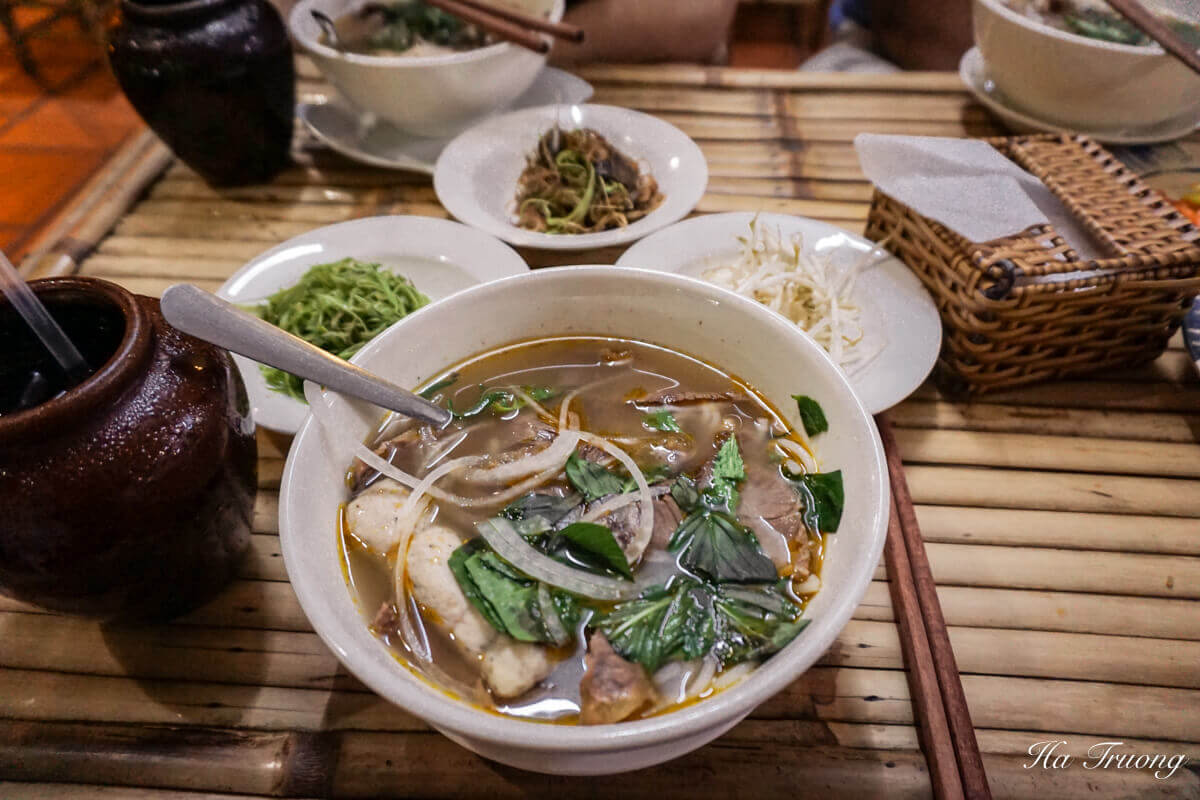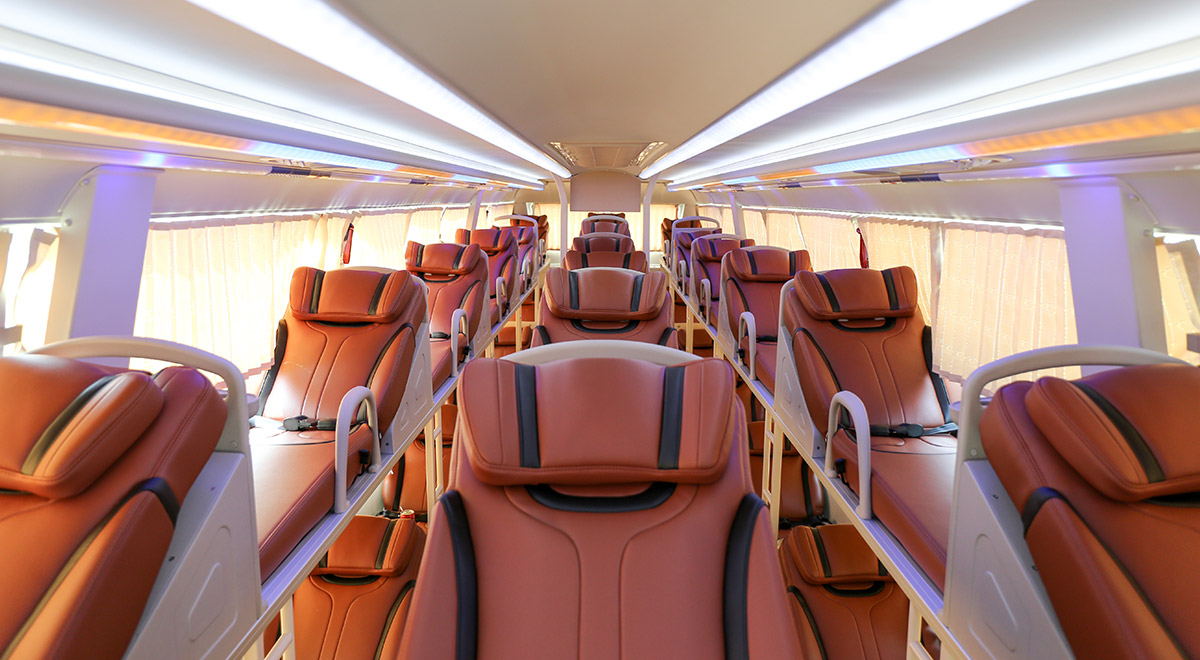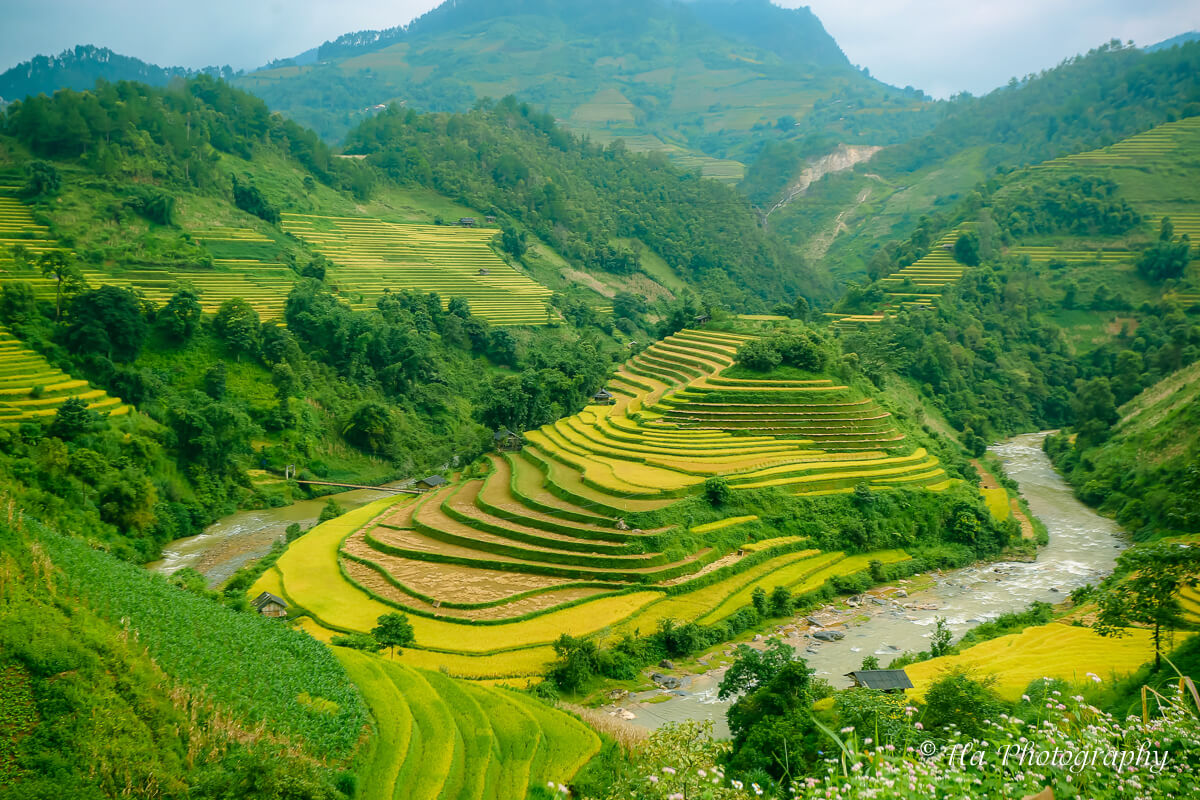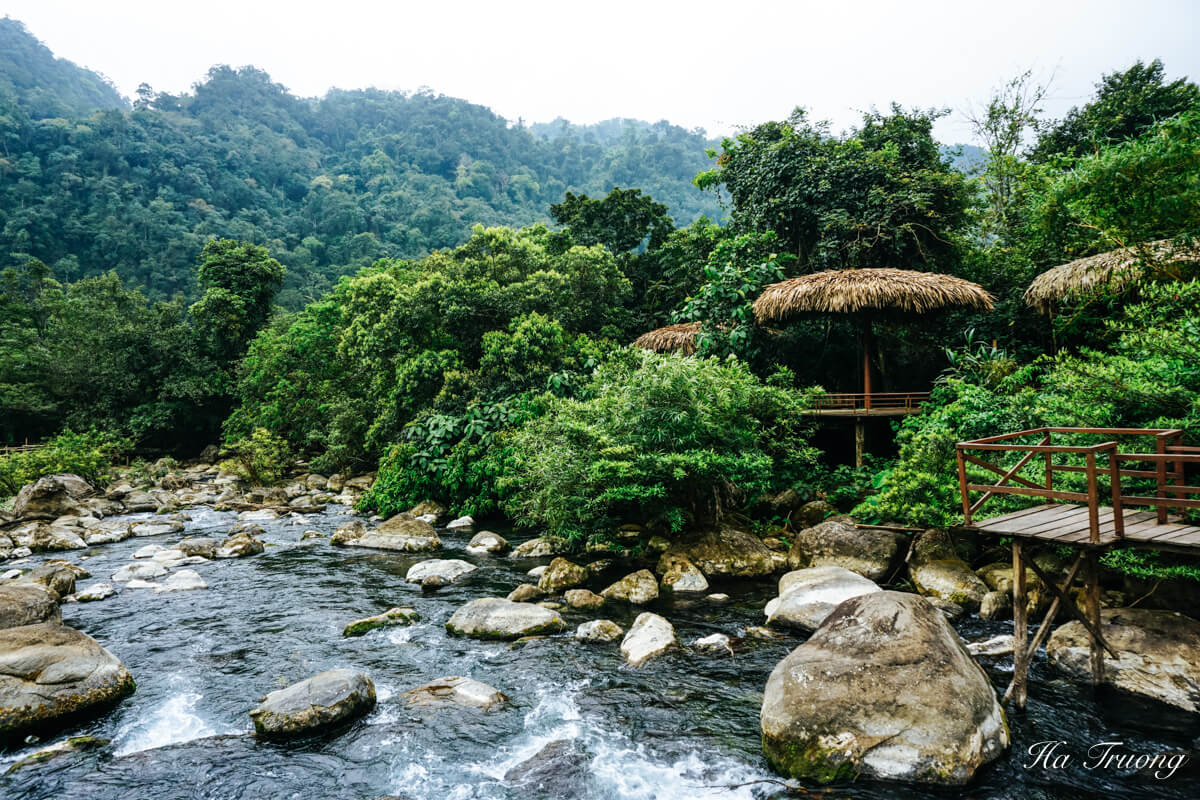Ha Giang Loop 4-Day Itinerary: Info & Tips
Have you ever dreamt of embarking on an epic motorcycle journey through stunning landscapes and exploring local cultures? If so, the Ha Giang Loop in northern Vietnam is an adventure to add to your bucket list.
Our Ha Giang Loop 4-day itinerary will take you on a thrilling ride through winding roads, majestic mountains, and charming villages, offering a glimpse into the raw beauty of Ha Giang province.
Ha Giang Loop Overview:
Here is a quick overview of what we did in our 4-day Ha Giang Loop journey:
- Day 1: Ha Giang – Yen Minh (90km): Bac Sum pass, Quan Ba Heaven Gate, Lung Khuy Cave
- Day 2: Yen Minh – Meo Vac (110km): Tham Ma Pass, Vuong’s Palace, Lung Cu Flag Tower, Vietnam’s northernmost point
- Day 3: Meo Vac – Du Gia (90km): Nho Que river boat tour, Tu San Canyon, Du Gia Waterfall
- Day 4: Du Gia – Ha Giang (100km): Lung Tam Village, Little Ma Pi Leng Canyon, back to Ha Giang. Relax in Ha Giang and head to the next destination.
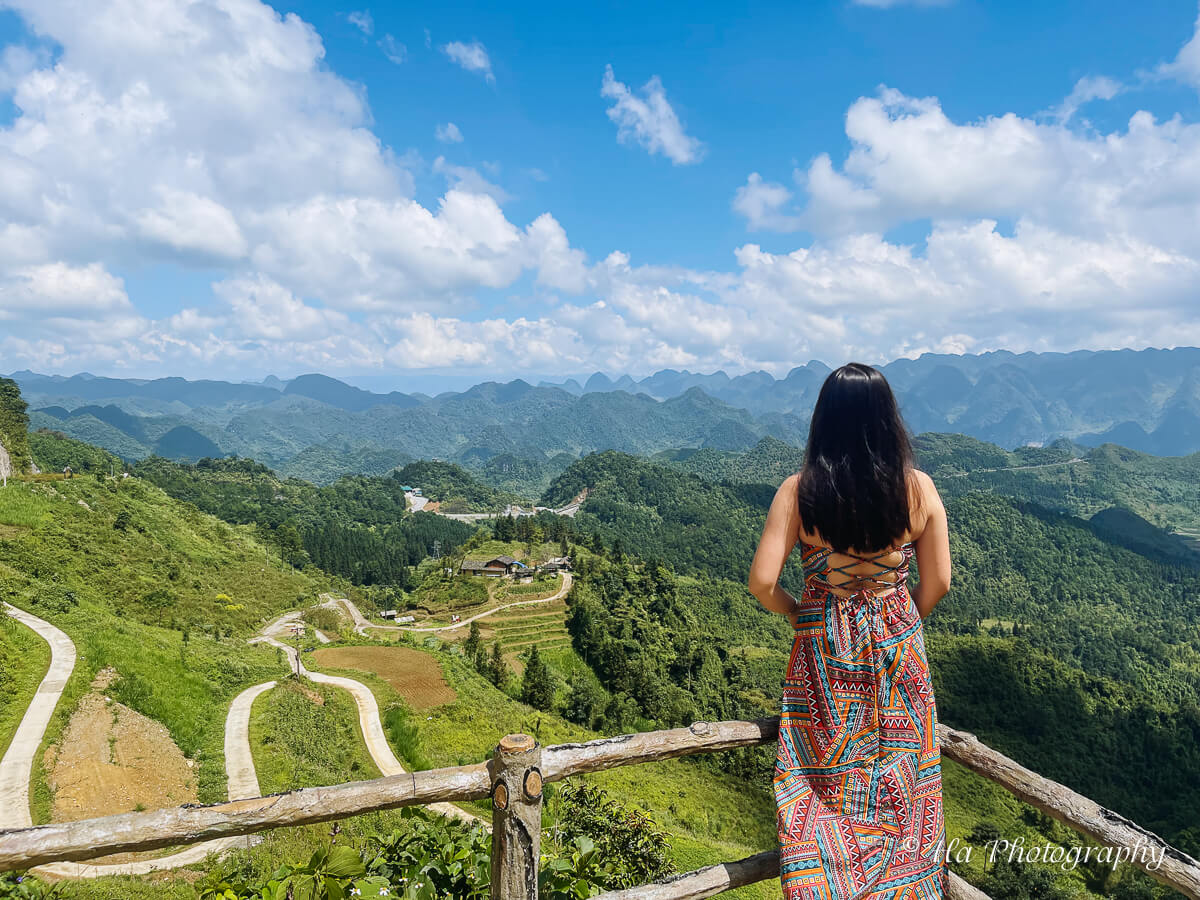
When is the best time to visit Ha Giang Loop?
The best time to visit Ha Giang is from the middle of September to November and from March to May.
During these months, the weather is pleasant, and the landscapes are vibrant with lush greenery or golden rice terraces, depending on the season.
You should avoid the rainy season (June to August) as the roads can become slippery and dangerous.

How much to budget for Ha Giang Loop?
Ha Giang loop budget really depends on your travel style and reference.
We traveled on a budget and stayed at guesthouses, so we spent around $50/ person per day.
Here are some expenses to consider:
- Accommodation: Homestays and guesthouses are popular options along the route, offering affordable and authentic experiences. Plan to spend around 200,000 ($10) to 300,000 VND ($15) per night.
- Food: Local eateries and street stalls offer delicious and reasonably priced meals. We spend around 100,000 to 150,000 VND per meal. Family dinner is more expensive, which is about 250,000 VND to 300,000 VND ($12 to $15).
- Bike rental fee: Expect to pay about 200,000 VND ($10) for a 125cc bike. If you want to rent a larger one, the price is more expensive.
- Fuel: There are just a few gas stations in Ha Giang Loop, so you should fill your tank whenever you see one. The approximate fuel cost is around 100,000 to 150,000 VND per day.
- Activities: Some attractions may have entrance fees or optional activities like boat tours. They can vary from just 20,000 VND ($1) to 120,000 VND ($6).
- Miscellaneous: Keep some extra cash for incidentals, such as snacks, drinks, and souvenirs. It’s always a good idea to carry some extra money in case of emergencies or unexpected expenses.

Where to stay in Ha Giang Loop
During our Ha Giang Loop adventure, we had the opportunity to explore various towns and communities along the way.
Here are some of our suggestions for where to stay in each destination, based on our personal experience:
Ha Giang city
Bong Hostel: We stayed at Bong Hostel and loved its cozy vibes. The dormitory rooms are clean and comfy, perfect for budget travelers. The staff is super friendly and always ready to share insider tips to help you make the most of your time in Ha Giang City.
Ha Giang Hostel: This centrally located hostel offers private rooms with modern amenities. And the rooftop terrace is a hidden oasis with stunning city views. It’s the ideal spot to unwind after a day of exploration.
Yen Minh
Tom Homestay: Our stay at Tom Homestay was nothing short of amazing. The warm and welcoming ambiance made us feel like part of the family, and the comfortable rooms and home-cooked meals were just what we needed.
Homestay Hoang Vu: Surrounded by breathtaking landscapes, this place offers traditional wooden stilt houses and mouthwatering homemade meals.
Dong Van
Dong Van Cliffside House: We love the panoramic views of the mountains and valleys here! The rooms are comfy, and the owners are friendly.
Ancient Town 29: This guesthouse seamlessly blends traditional architecture with modern comforts. Plus, being centrally located, you can easily explore the lively markets and historical sites.
Meo Vac
Meo Vac Clay House: These traditional Hmong-style clay houses are not only charming but also comfortable. We enjoyed the spa and dinner here.
Lo Lo Homestay: We were impressed by the intricate wooden carvings on the traditional house. The hosts are incredibly warm and welcoming, and their Lo Lo dishes are yummy.

Du Gia
Du Gia Village Homestay: If you’re looking for a rustic retreat, Du Gia Village Homestay is where it’s at. The traditional wooden houses nestled amidst serene landscapes create a tranquil haven.
Du Gia Coc Bang homestay: Surrounded by the beauty of the Coc Bang River, this homestay offers a slice of paradise. The hosts are incredibly welcoming, and their family dinner is delicious too.
What should I pack for Ha Giang Loop?
When packing for the Ha Giang Loop, you should be prepared for various weather conditions and road conditions.
Here are some essential items to consider:
Protective gear: A sturdy helmet, riding jacket, gloves, and boots are important for your safety. They provide protection in case of any mishaps or accidents. Ask your bike rental place for these gears!
Layered clothing: The weather in the mountains can be unpredictable, so pack both warm and lightweight clothing. Layers allow you to adjust your attire according to temperature changes throughout the day.
Rain gear: A waterproof jacket and pants or a rain poncho can be a lifesaver during unexpected rain showers. Usually, bike rental places provide these!
Comfortable footwear: Opt for sturdy and comfortable shoes that provide a good grip for walking and exploring off the bike.
Essentials: Don’t forget sunscreen, insect repellent, a first aid kit, and any necessary medications. It’s also wise to carry a portable charger and a basic toolkit for minor bike repairs.

Ha Giang Loop 4-day itinerary: What we did
So here is a detailed journey of what we did on 4 days in Ha Giang Loop.
Day 1: Ha Giang – Yen Minh
On the first day of our itinerary, we embarked on an adventure from Ha Giang to Yen Minh.
Starting from our hostel in the morning, we hopped on our motorbikes and hit the road.
After passing Bac Sum Pass, we made a pit stop at the Quan Ba Heaven Gate, a scenic viewpoint that offered a panoramic vista of the surrounding mountains.

After a thrilling ride, we found a local eatery and had lunch.
We then headed into the Lung Khuy Cave, a hidden gem that revealed a mysterious underground world. The stalactites and stalagmites had intriguing formations.
As the day wore on, we arrived in Yen Minh and checked into a cozy homestay. The warm hospitality of the hosts made us feel right at home.
In the evening, we gathered around for a delightful family dinner and tried the locally famous “happy water”!
Day 2: Yen Minh – Meo Vac
The second day of our journey took us from Yen Minh to Meo Vac, promising even more captivating sights.
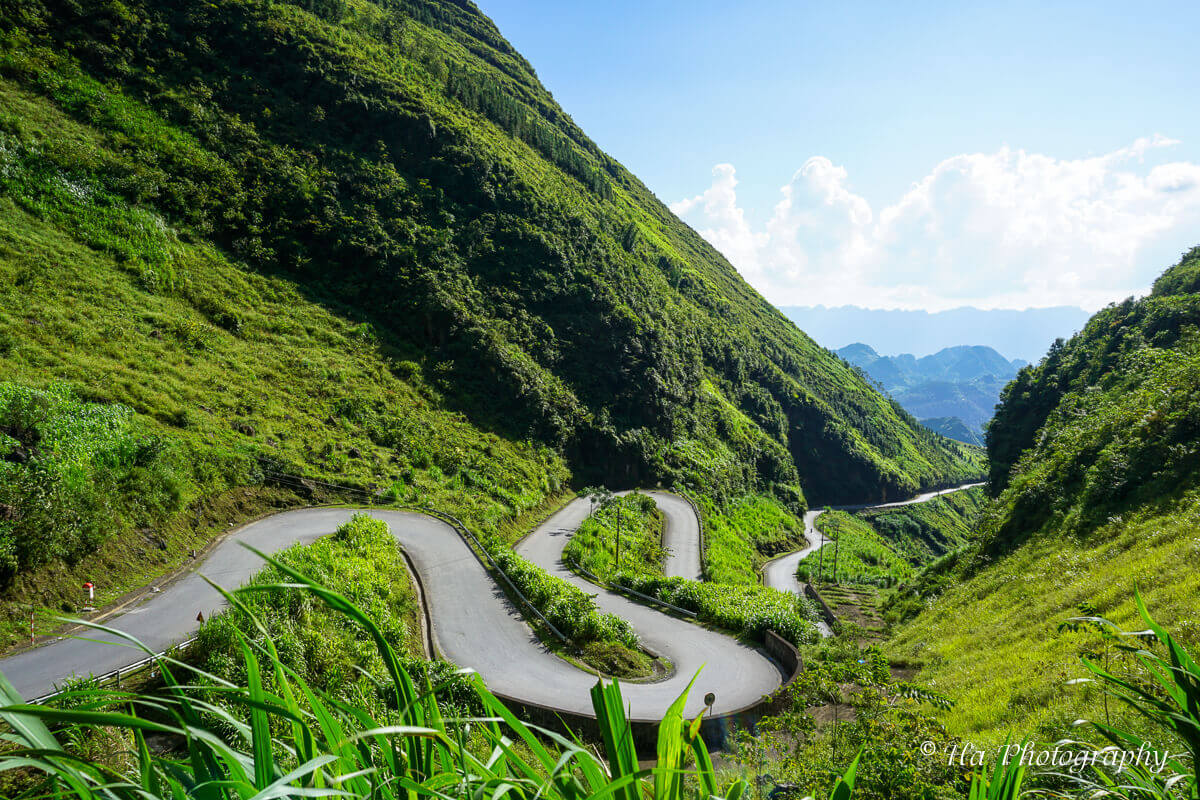
After our breakfast, we set off toward our next destination.
Along the way, we conquered the Tham Ma Pass, with its hairpin turns and breathtaking views.
The journey was challenging yet rewarding, as we basked in the region’s natural splendor.
We also stopped by the famous Lonely Tree in Ha Giang loop for some quick photos and snacks.

Our next stop was Hmong King Palace, a historical site that offers insights into the intriguing past of the Hmong ethnic minority.
Exploring traditional architecture and learning about the royal history of the palace was a fascinating experience.

From there, we continued our ascent to the Lung Cu Flag Tower.
Climbing the tower rewarded us with panoramic views of the sprawling valleys and distant mountain ranges. There were a lot of people when we got there already!
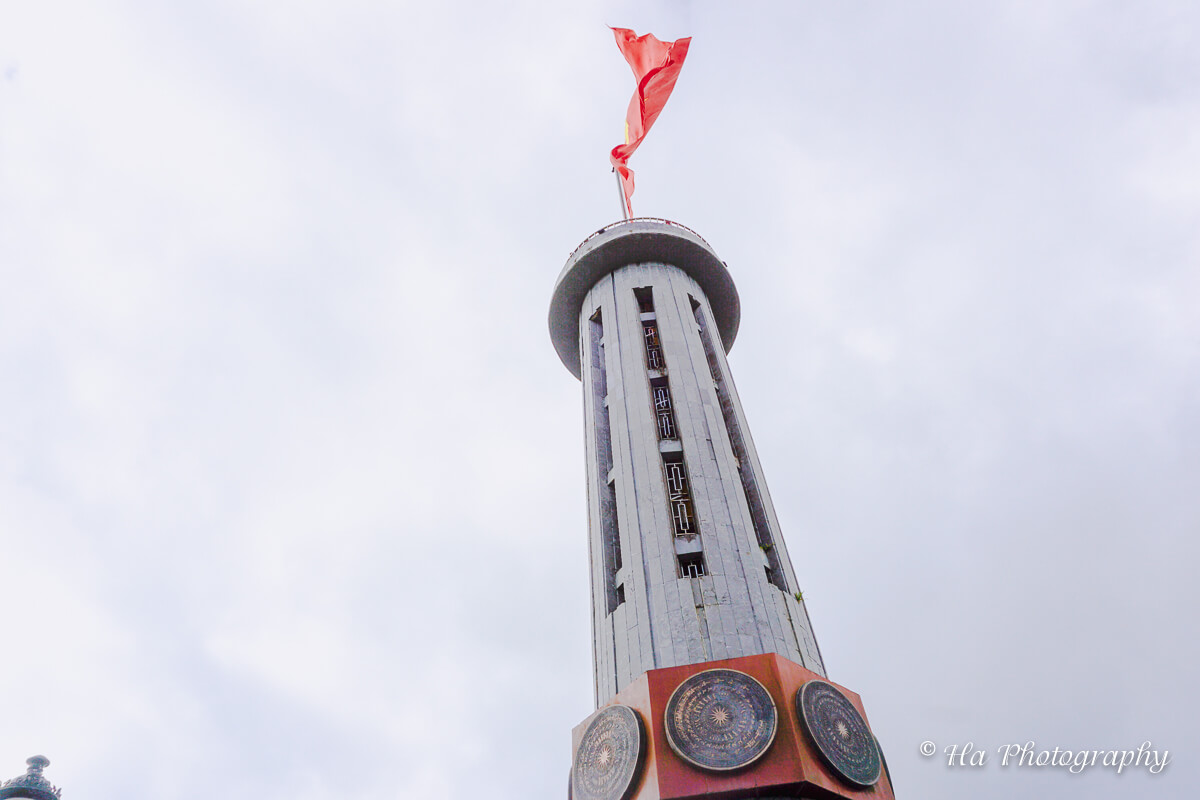
We spent about 30 minutes there and continued on our trip to the Northernmost point of Vietnam. From there, we could see the Chinese border.

After a flavorful lunch in Dong Van Town, we continued our journey, eagerly anticipating one of the highlights of the day—the Ma Pi Leng Pass.
Known as the “King of All Passes,” Ma Pi Leng offers an awe-inspiring ride along towering cliffs and steep valleys. The road seems to defy gravity as it clings to the mountainside, providing breathtaking views at every turn.
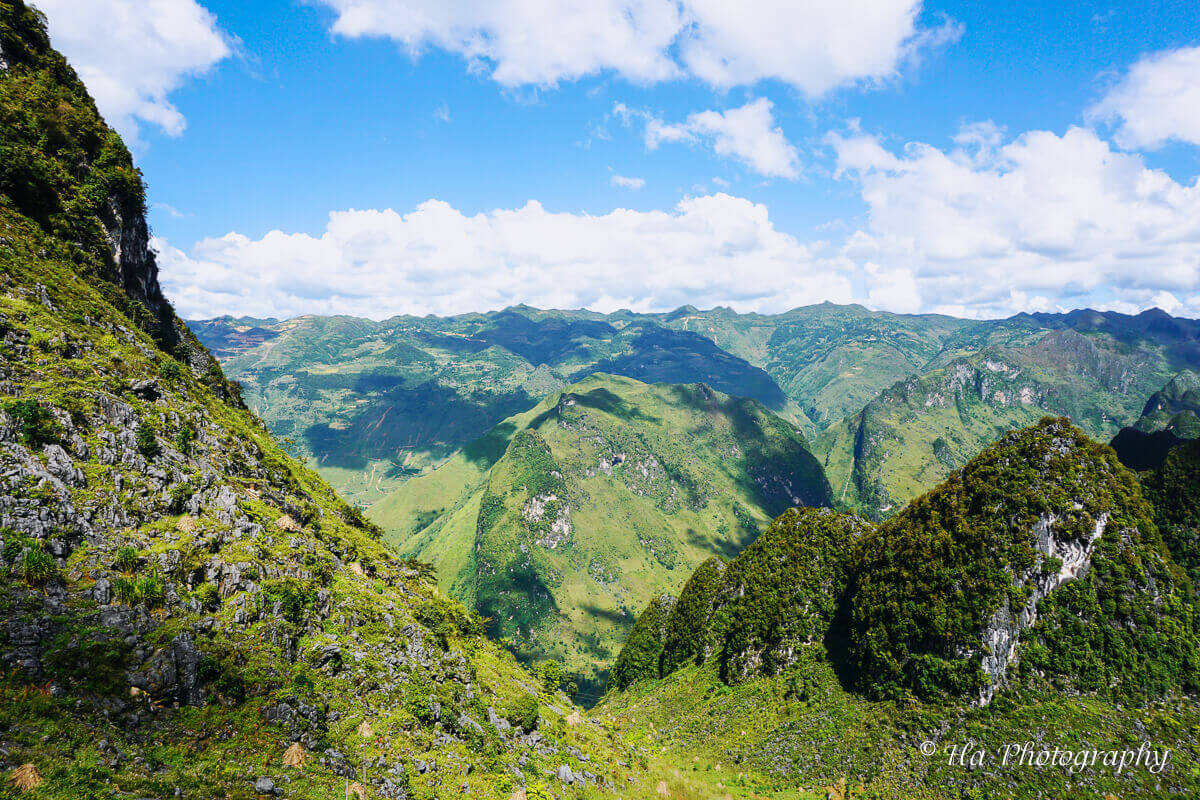
By late afternoon, we arrived in Meo Vac and settled into our homestay in Pa Vi Village. We had another family dinner, where we tried local cuisine and watched some dances.
Day 3: Meo Vac – Du Gia
Day three greeted us with the promise of more exploration.
Our journey from Meo Vac to Du Gia took us through captivating landscapes and hidden gems.

We joined a boat tour along the Nho Que River and enjoyed the serenity of the surroundings.
The Tu San Canyon was breathtaking with its dramatic rock formations and winding paths, and the towering cliffs and emerald waters created a mesmerizing backdrop as we cruised along.
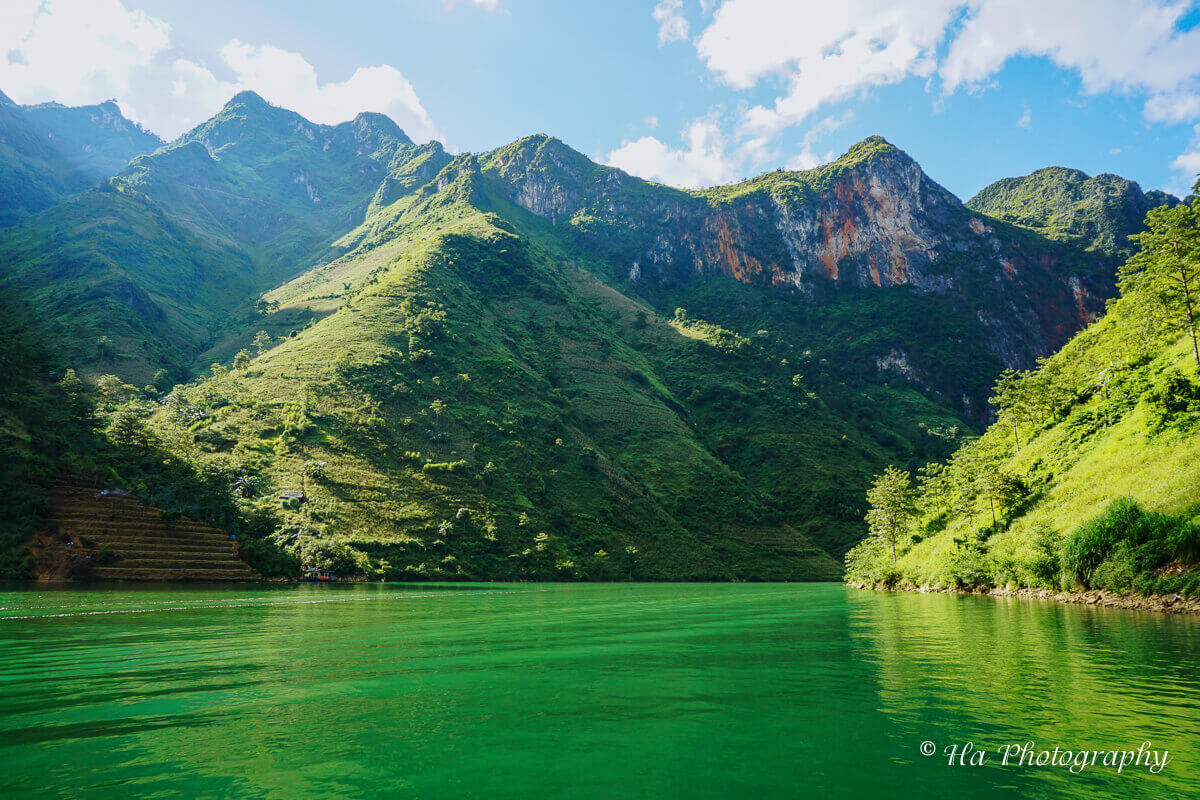
After a delicious lunch in Mau Due, we continued our journey towards Du Gia.
The M pass welcomed us with its challenging terrain, but the thrill of conquering it was incomparable.
As we rode through the winding roads, we were rewarded with stunning vistas of the surrounding mountains and valleys. It was a true test of riding skills, but the sense of achievement was immeasurable.
Upon reaching Du Gia Village, we were greeted with warm hospitality at our homestay.
We took a nap and headed to Du Gia Waterfall, which was just about 3 km from our homestay. We did a little trek at the leg end of the trip, and the natural beauty of the waterfall welcomed us.
As the evening descended, we gathered for another memorable family dinner, sharing stories while savoring traditional dishes.
Day 4: Du Gia – Ha Giang
Our fourth and final day marked the return journey from Du Gia to Ha Giang.
The scenic beauty of the Tam Son Town and its surrounding areas left us amazed.
We also visited Lung Tam Village, where we saw the skillful art of traditional textile weaving. The intricate patterns and vibrant colors showcased the rich cultural heritage of the region.
Our excitement grew as we approached the Little Ma Pi Leng Canyon, a hidden gem that offered breathtaking views of the winding river and towering cliffs.
It was the perfect spot to reflect on our incredible journey and enjoy the natural wonders that surrounded us. The serenity of the canyon was a fitting farewell to the Ha Giang Loop.
Finally, we reached Ha Giang, completing the remarkable circuit that had taken us through some of the most stunning landscapes in Vietnam.
We were super tired, but the trip was worth it! It had not only been an exhilarating adventure but a great way to connect with nature. The hospitality of the local people, the awe-inspiring landscapes, and the thrill of exploration had left us several memories.
Tips for Ha Giang Loop Adventure
Before starting your Ha Giang Loop, here are some useful tips.
Plan Sufficient Time: The Ha Giang Loop is best experienced over four days to fully enjoy its beauty and culture. Rushing through the route won’t allow you to appreciate all its wonders.
Get a Reliable Motorbike: Rent a sturdy and reliable motorbike from a reputable rental agency to ensure a smooth and safe journey. Inspect the bike thoroughly before setting off and carry essential tools and spare parts.
Pack Essentials: Pack light but make sure to bring essential items such as sunscreen, insect repellent, a first aid kit, and appropriate clothing for varying weather conditions. Don’t forget to bring a good quality helmet and protective gear.
Embrace the Local Culture: Interact with the local communities, learn about their traditions, and respect their way of life. Engage in conversations, taste the local cuisine, and participate in cultural activities to make the most of your experience.
Stay in Homestays: Opt for homestays along the route to connect with the local culture and enjoy authentic hospitality. The families are incredibly welcoming, and the cozy accommodations provide a unique glimpse into their daily lives.
Stay Hydrated and Fuel Up: Carry enough water with you during the journey to stay hydrated, especially during hot weather. Fuel stations are limited along the route, so keep an eye on your fuel level and refuel whenever necessary.
Ride Safely: The roads of the Ha Giang Loop can be challenging, with steep ascents, sharp bends, and occasional unpaved sections. Ride at a comfortable pace, stay focused, and be cautious of other vehicles and livestock on the road.
Respect the Environment: The Ha Giang Loop is a pristine natural paradise, so make sure to leave no trace behind. Dispose of your waste properly, respect wildlife, and adhere to responsible tourism practices.

FAQs
For those considering embarking on the Ha Giang Loop, here are some frequently asked questions to help you plan your own unforgettable adventure:
Is it necessary to have riding experience to do the Ha Giang Loop?
While riding experience certainly helps, it is not an absolute requirement. However, you should be confident on a motorbike and have basic riding skills. The roads can be challenging, with steep inclines, hairpin turns, and uneven surfaces.
If you are a beginner, consider taking a few riding lessons or practicing on less demanding routes before attempting the Ha Giang Loop.
Do I need a motorbike to explore the Ha Giang Loop?
Renting a motorbike gives you the freedom to explore at your own pace and deviate from the main route. However, if you are not confident riding a motorbike or prefer a guided experience, joining a tour is a great option. There are several tour operators in Ha Giang that offer guided tours of the loop, providing you with a knowledgeable guide who knows the best routes, stops, and accommodations along the way. This can be especially beneficial if you are new to riding or prefer the convenience of having logistics taken care of for you.
Can I do the Ha Giang Loop solo?
While the Ha Giang Loop can be done solo, it’s important to exercise caution and prioritize your safety. Familiarize yourself with the route, check weather conditions, and ensure your motorbike is in good condition before setting off. It’s advisable to inform your accommodation hosts or a trusted person about your itinerary and expected return time. Additionally, keep emergency numbers handy and have a basic understanding of bike maintenance in case you encounter any issues on the road.
Do I need a permit to travel to Ha Giang?
Yes, a permit is required to travel to certain areas of Ha Giang, including the Dong Van Plateau and Meo Vac District. You can obtain the permit either through a tour operator or by visiting the Ha Giang Immigration Office.
Is it safe to ride a motorbike in Ha Giang?
Riding a motorbike in Ha Giang requires caution and experience, especially due to the winding roads and steep cliffs. It’s important to wear protective gear, follow traffic rules, and drive at a comfortable pace. If you’re not confident riding a motorbike, consider alternative transportation options.
How physically demanding is the Ha Giang Loop?
The Ha Giang Loop can be physically demanding, particularly due to the long hours of riding and the challenging terrain. You will encounter steep inclines and winding roads, requiring a certain level of stamina and physical fitness. Regular breaks and staying hydrated are crucial to maintain your energy levels throughout the journey.
How can I navigate through the Ha Giang Loop without getting lost?
Navigation can be a concern, especially since GPS signals may be weak or nonexistent in some remote areas. It’s recommended to have a detailed map or a navigation app that works offline.
Also, you can ask for directions from locals or other travelers along the route, as they are often happy to help and provide guidance.
Are there accommodations and food options available along the Ha Giang Loop?
Yes, there are various accommodations available along the Ha Giang Loop, ranging from homestays to guesthouses and hotels. The villages you pass through offer traditional homestays, allowing you to experience the local culture firsthand.
As for food, you’ll find small local eateries and restaurants in the towns where you can enjoy a variety of Vietnamese dishes. Vegetarian options may be limited, but most places can accommodate dietary preferences with advance notice.
Are homestays a good accommodation option in Ha Giang?
Homestays are a popular and authentic accommodation option in Ha Giang. They provide an opportunity to experience the local way of life, connect with friendly hosts, and indulge in delicious homemade meals. Homestays range from basic to more comfortable, so you can choose according to your preferences.
Can I customize the Ha Giang Loop itinerary?
Absolutely! While the 4-day itinerary is a popular choice, you can extend or shorten your trip based on your preferences and available time. You can add extra days to explore specific areas in more detail or take detours to visit off-the-beaten-path attractions. The freedom to tailor your journey allows you to make the most of your experience and discover hidden gems along the way.
Should I do Ha Giang Loop 4 days or 3 days?
We recommend spending at least 4 days doing Ha Giang Loop because there are plenty of things to see along the way. Also, spending one day before and one day after in Ha Giang City to rest would be the best.
Final thoughts
Ha Giang Loop is an adventure that will leave you breathless, both from the stunning landscapes and the warmth of the local communities.
From the exhilarating mountain passes to the serene ethnic villages, this journey takes you on a whirlwind tour of Vietnam’s hidden gem.
So pack your bags, hop on a motorbike, and get ready for an unforgettable experience. Safe travels!
